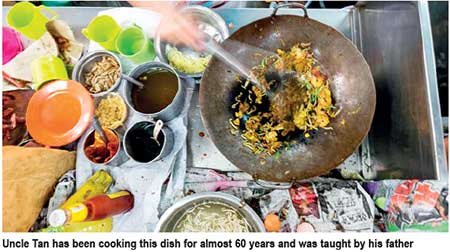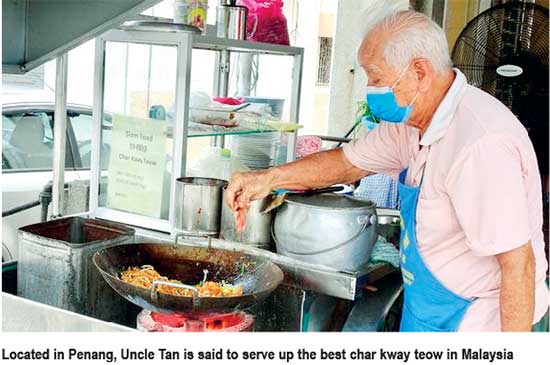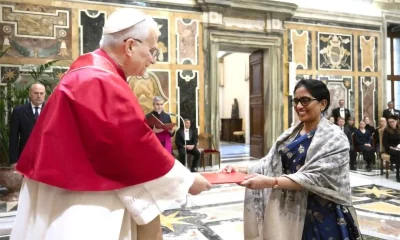Life style
King of Noodles

Food-loving Malaysians have been known to debate the best local food spots for hours. Tan Chooi Hong, hunched over a blazing hot wok, hadn’t broken a sweat. Flames from the charcoal sparked and danced up the side of the wok, crackling as he added the ingredients one by one, just as his father taught him almost 60 years ago. Char kway teow, Malaysia’s most famous street food, is a simple rice noodle dish made with soy sauce, eggs, cockles, bean sprouts, Chinese sausage and a couple of shrimp. It’s common throughout the country – devoured at roadside stalls or feasted on at hawker centres – but there is only one “king” of char kway teow, and he’s in Penang. Uncle Tan, as he’s known, is a sturdy 79-year-old with a shock of white hair and an all-knowing glimmer in his eye. He’s been cooking this single dish from a wok-cart attached to a bicycle and pushed into place on the side of Siam Road in central George Town for decades. “I don’t remember how old I was when I started. But char kway teow is all I know,” said Uncle Tan.
Uncle Tan’s unlikely fame began in 2012 when he was interviewed by a local who put the story on Facebook. His decades of cooking experience, combined with layered flavours of smoky-unctuous noodles perfectly balanced with the salty-sweet Chinese sausage, quickly got the younger generation of foodies salivating. Nothing is better than a simple noodle dish with an interesting backstory, and young Penangites ate it up. The article went viral and people began flying to the island just to taste his dish.
 In 2015, celebrity chef Martin Yan, known for his Yan Can Cook TV show, visited the stall for his TV show Taste of Malaysia. If that fame didn’t cement Uncle Tan’s title as king, placing 14th (out of 50) at the World Street Food Congress in 2017 certainly did. Today, his roadside wok-cart is a fixture in the food scene and he’s widely revered as serving up the most delicious, flavoursome char kway teow in Malaysia, churning out hundreds of plates a day with people waiting in line for hours.
In 2015, celebrity chef Martin Yan, known for his Yan Can Cook TV show, visited the stall for his TV show Taste of Malaysia. If that fame didn’t cement Uncle Tan’s title as king, placing 14th (out of 50) at the World Street Food Congress in 2017 certainly did. Today, his roadside wok-cart is a fixture in the food scene and he’s widely revered as serving up the most delicious, flavoursome char kway teow in Malaysia, churning out hundreds of plates a day with people waiting in line for hours.
Uncle Tan is unfazed by his fame and prefers to keep a low profile. Humble and shy, he can’t understand what all the fuss is about and doesn’t think his version is any better than anoyone else’s.
“My dad didn’t go to school to learn any skills. It wasn’t an option. He had to work for his father, so he worked by his side cooking char kway teow every day,” his daughter, Tan Evelyn, told . “And he’s never stopped.”
The ingredients of char kway teow are so simple that it takes a lot of skill to get it right. The main ingredient is flat rice noodles. No self-respecting char kway teow stall would use dried noodles, so Uncle Tan gets bags of the fresh, chewy goodness delivered by scooter regularly.
I watched as he skillfully added one ingredient at a time, just by feel and sight. He threw a large handful of slippery noodles in the blisteringly hot wok and used a wide metal spatula to spin them around in the garlic and lard waiting for them. After pushing the noodles up the side of the pan, he expertly cracked an egg into the middle, breaking it with the spatula to let the yolk ooze into the noodles.
A few soy sauce dashes, a spoonful of chilli sauce and a little water created a silky sauce that the noodles absorbed. Then Uncle Tan tossed in a couple of shrimp and a few slices of sweet lap cheong, or Chinese sausage. Finally, a smattering of cockles got a spin in the wok. He topped it all with a handful of crunchy bean sprouts, chives and small homemade croutons made of crispy pork fat.
He eyed the steaming noodles for the perfect consistency and then scooped them onto a melamine plate and started all over again. The whole process was lightning fast – less than two minutes – and Uncle Tan made it look effortless.
While many stalls use gas, Uncle Tan cooks on charcoal, frying one order at a time for maximum flavour and wok hei, which translates to “breath of the wok”. Wok hei is the smoky depth of flavour that charcoal adds to the dish and is expertly created by cooking the right portion over the right temperature. It’s something that gas heat cannot achieve.
Some people say that charcoal is the secret to Uncle Tan’s success, but, “they like my father’s char kway teow better than others because he’s perfected it over 60 years,” said Evelyn. “Other stalls use charcoal and the same ingredients, but no-one has his skill. Not even my brother Kean Huat who learned from him.”
Others try to attribute Uncle’s success to a secret sauce. “I promise. There is no secret sauce; it’s his wok skill,” said Evelyn. “I also cannot fry as my brother or dad. My brother has been working for years learning from my dad, and his skills are still improving. It takes a lifetime. Just ask my dad.”
“If I give you the same ingredients, you cannot make the same taste as me,” agreed Uncle Tan.
Even though char kway teow has become synonymous with Penang street food, its origins lie in China. In the 19th Century, the Chinese diaspora brought over Teochew and Hokkien people from Guangdong and Fujian provinces on China’s south-eastern coast. During that same time, Penang grew under British rule and it became a bustling entrepot providing greater employment opportunites. The Hokkien people came to work in the rubber plantations and as traders and merchants, while the Teochew found jobs in the tin mines and as fisherman. With them came some of their kitchen staples like soy sauce, bean curd and noodles called kway teow.
In Hokkien, the word char means “stir-fried”, and kway teow means “rice cake strips”, referring to the noodles. What had begun in China’s south-eastern provinces as a simple noodle dish with pork, fish sauce and soy sauce was transformed into a seafood delight once it hit the island’s shores. Initially, it was sold at night by fisherman and cockle gatherers trying to make an extra buck. Instead of the traditional ingredients, they used what was plentiful to create a revised version of the dish. It was a poor man’s food and the other Chinese immigrants devoured it as something fast, cheap and tasty to sustain them for hours under the hot sun. The dish became a labourer’s staple.
“When the waves of Teochew and Hokkien immigrants came from China, they came alone, leaving their wives and families behind. Since there was no-one to cook for them, they survived on cheap street food,” said Nazlina Hussin, a Penangite culinary specialist and author. “From wok to plate, char kway teow takes no time. These men could stop for lunch, eat and be back to work within a few minutes.”
To this day, most of the Chinese in Penang are of Hokkien and Teochew descent. It’s the only place in Malaysia where Hokkien is commonly spoken, which is why char kway teow has remained so closely linked to Penang. And although you can find the dish outside of Penang, locals say it’s not as good unless a Hokkien or Teochew makes it. That’s why people fly here from Kuala Lumpur and Singapore and wait in line for hours, in the hot sun, to try Uncle Tan’s char kway teow.
It’s that good.
Plus, he’s one of the oldest char kway teow legends in Malaysia. There is a reverence in that. “Most customers come here for my dad. People say he’s a char kway teow idol. So, if he’s not cooking, they keep on driving,” said Evelyn.
In 2018, for the first time in nearly 60 years, Uncle Tan took a break. On doctor’s orders after cataract surgery, he closed his shop for six months, and his devotees, like those of any idol or guru, went berserk. The whole island almost had a breakdown, with stories in local media lamenting his sudden overnight retirement. “Today we’ve had to endure the greatest loss of mankind,” wrote culinary website Penang Foodie. “Siam Road Char Koay Teow is believed to be closed down for go
Uncle Tan’s son took over for a brief moment and locals weren’t kind to him; Penangites are loyal foodies and they wanted the master’s char kway teow. After six months of ever-more grandiose gossip, “We had to find a place; we couldn’t let the people down,” declared Evelyn. Instead of going back to his original roadside spot, they decided to find a premises on the same street. Today Uncle Tan still cooks from a bike pushcart with a wok attached; it’s just parked in front of his shop.
He’s widely revered as serving up the most delicious, flavoursome char kway teow in Malaysia
“Now, my son and I can take turns cooking. When I get tired, I can sit down and watch Kean Huat try to perfect my dish,” he said with a wink. “It isn’t easy. But he’s a third-generation char kway teow cook, and even though he didn’t start as young as I did, he’ll be able to perfect his skills one day too.”
Uncle Tan’s char kway teow is not only Penang’s history on a plate; it’s his family’s history as well. Hopefully, Kean Huat will live up to his father’s reputation and teach future generations how to follow in the king’s footsteps.
But until then, “I have no plans to retire. As long as I can still stand and cook over the wok, I’ll be here on Jalan Siam,” laughed Uncle Tan.–BBC
Life style
Aslam Hussein’s Couture and Trousseau

 At Colombo Fashion Week,held recently at Cinnamon Grand,designer Aslam Hussein delivered a collection that spoke the language of quiet confidence and refined glamour, positioning him firmly as a Fashion Edit, favourite this season.
At Colombo Fashion Week,held recently at Cinnamon Grand,designer Aslam Hussein delivered a collection that spoke the language of quiet confidence and refined glamour, positioning him firmly as a Fashion Edit, favourite this season.
‘His collection unfolded like a carefully composed symphony – each piece moving with a rhythm of elegance and poise. Aslam Hussein’s runaway was more than a presentation – it was a story of refined luxury, individuality and timeless beauty where couture met emotion and each garment became a living expression of artistry.
Colombo Fashion Week was held this November at Cinnamon Grand ,namely Couture + Trousseau . The event was part of the luxury edit focused on high fashion,bridal wear and destination wedding,celebrating CFW’’s 22 rd anniversary Aslam Hussein opened the runway and his collection balanced sharp tailoring with fluid silhouettes, creating looks that felt both modern and enduring. Clean lines, thoughtful construction and an understated palette allowed craftsmanship to take centre stage. The colour palette was muted yet rich, allowing texture and craftsmanship to speak. Luxurious fabrics caught the light with every step, revealing subtle interplay between movement and form. Each silhouette told a story of – timeless, modern and effortless elegance
Fluid silhouettes, muted palettes and clean tailoring defined his collection.
On the ramp,models moved with understated confidence, their hairstyles were created by. Ramani Fernando salons,the soft luminous makeup complemented the collection’s quiet sophistication. Each silhouette reflected Aslam’s commitment to craftsmanship, versatility and timeless style. Since establishing his label, he has been a staple on Sri Lanka’s fashion calendar, consistently presenting at Colombo Fashion Weeks and earning recognition for his designs.
His collection this year re-affirmed his mastery of understated elegance and contemporary luxury. Neutral tones were punctioned with occasion, deep shades, allowing fabric, cut and texture to take centre stage. Models carried the collection with measured poise. Make up was luminous yet natural, letting the silhouettes and individual model presence shine. Through his designs, Aslam Huseein has cultivated a following among modern cosmopolitan clientele who appreciate understated glamour, versatility and the quiet power of elegance.
His contributions have solidified his reputation as a designer who bridges Sri Lanka’s rich fashion heritage with an international sensibility.
Colombo Fashion Week is Sri Lanka’s premier event, showcasing the country’s top designers alongside emerging talent and is one of the glamorous events in the fashion landscape. The visionary is Ajay Vir Singh, founder of Colombo Fashion Week, whose leadership continues to elevate Sri Lanka’s premier fashion platform to international level.
Life style
Hairstyle maestro: Niroshan at Ramani Fernando salon at Mount Lavinia

Ramani Fernando salons is a name that has taken men and women’s grooming to new heights since its inception at Mount Lavinia. The salon has made its mark on the locals and celebrities alike. Over the years, Ramani Fernando Salons has not just set a benchmark for luxury grooming services but has also redefined how men perceive self-care, hair styling, and professional grooming. This salon at Mount Lavinia under its Manager Kappitiya Godage, namely Niroshan known by clients has become a favourite destination for those who sought more than just a haircut. The salon introduces a range of services—from precision styling and beard grooming to men’s makeup for photoshoots. The manager at Mount Lavinia is Niroshan Suresh. His philosophy emphasized that grooming is not just about appearance but also about confidence and self-expression and most importantly – self-care. He says make-up and grooming are not just limited to the opposite gender!
What makes Ramani Fernando Salon at Mount stand out. It is its innovative style and technique to men and women’s grooming. This branch prides itself on using cutting-edge tools and premium products that ensure every client leaves with a polished, customized look. The salon focus is on continuous learning and staying ahead of trends has earned it the loyalty of a discerning clientele.
Working at Ramani salons, Niroshan has spent many years perfecting the craft of styling, cutting and grooming men’s and woman’s hair, blending technical skill with a keen understanding of contemporary fashion trends. With years of experience, he guides clients on hairstyles and on the selection and proper use of styling products. His presence at Ramani Fernando salon at Mount Lavinia reinforce the brand’s reputation for excellence but also highlights the vital role of a skilled male stylist in shaping men and women’s grooming culture in Sri Lanka.
In the evolving world of men’s grooming, where style isn’t just about guiding a haircut but crafting a confident identity Niroshan at Mount Lavinia represent more than just a stylist or a place to cut hair. With Niroshan at the helm, this salon has become a place where style, innovation and meticulous grooming are curated for any client who walks in.
He is part of Ramani Fernando salons creative team, and brings creativity and precision to every look reflecting the high standards of Ramani Fernando’s renowned beauty collection
Niroshan has been with Ramani Fernando for several years and he is popular among his clients for those seeking sharp, modern and personalised hairstyles. With many years of experience, he has combined technical expertise with an eye for current trends ensuring each client leaves the salon looking confident and polished, Niroshan begins with a consultation, he carefully considers face shape, hair texture and personal style before recommending a look: He tailors each style to suit individual preferences, while ensuring easy to maintenance.
Beyond haircuts and grooming, his services include beard shaping, scalp and hair treatments and guidance on styling products. He makes each client of his leave the salon not just with a haircut but walk with confidence. He enjoys seeing his clients happy and self-assured. His experience, professionalism and knowledge make him a standard stylist in Colombo’s competitive grooming scene. He is very grateful to his senior and dynamic hairdresser Kamal for his guidance and expertise and who has been instrumental in shaping his approach to styling and artistry
by Zanita Careem ✍️
Life style
The Kingsbury, Colombo, Welcomes Season of Splendour

The Kingsbury, Colombo, welcomes the festive season with a spirit of warmth, elegance and celebration. This year’s Christmas and New Year offerings have been curated to bring guests together through moments of comfort, connection and shared joy across the hotel.
Harbour Court sets the tone for the season with its Christmas Eve Dinner Buffet, Christmas Day Brunch and Christmas Dinner on 24th and 25th December, followed by the New Year’s Eve Dinner Buffet on 31st December and the New Year’s Day Lunch and Dinner Buffets on 1st January. Kings Steakbar brings festive fine dining to Colombo with its Sunday Gourmet Carvery every Sunday in December, the Christmas Gourmet Carvery on 24th and 25th December, an á la carte Christmas Dinner on Christmas Day and a Seven-course Gourmet Dinner on New Year’s Eve.
Yue Chuan offers authentic Chinese cuisine with its signature Peking Duck Experience throughout December, daily Dim Sum and a special All You Can Eat menu on 24th, 25th and 31st December. At Tenk?, guests can enjoy elegant Japanese cuisine with the daily Teppanyaki Show, festive á la carte menus on 24th and 25th December and a New Year’s Eve Tasting Menu. Ocean highlights the best of coastal cuisine with festive á la carte menus on 24th, 25th and 31st December. Bringing Sri Lankan authenticity to the season, Tavern presents an Arrack Tasting Experience throughout December.
Festive cheer continues outdoors at Honey Beach Club with live music from 19th to 23rd December, poolside Festive party packages, and the signature New Year’s Eve celebration “Dancing Into 2026,” featuring Infinity and DJ E2. At Sky Lounge, guests can enjoy elevated festivities with Corporate Celebration packages, festive set menus, seasonal cocktails and the New Year’s Eve event “Party in the Sky,” featuring The Kingdom. Seas
For those celebrating at home, The Kingsbury offers Seasonal Roasts and festive hampers, available both ready-made and customisable, while Indulgence provides five-star delivery throughout the season. Families can also enjoy special offers, with children below six dining free and children aged six to ten receiving 50% off buffet dining. Seasonal cocktails, wine menus and bottle deals are available across all outlets.
This year, The Kingsbury, Colombo, invites guests to embrace the season with kindness, hope and cherished moments. Whether dining out, gathering with loved ones or gifting thoughtfully, we are honoured to share a season of splendour with you.
-

 News1 day ago
News1 day agoMembers of Lankan Community in Washington D.C. donates to ‘Rebuilding Sri Lanka’ Flood Relief Fund
-

 News6 days ago
News6 days agoPope fires broadside: ‘The Holy See won’t be a silent bystander to the grave disparities, injustices, and fundamental human rights violations’
-

 News6 days ago
News6 days agoPakistan hands over 200 tonnes of humanitarian aid to Lanka
-

 Business5 days ago
Business5 days agoUnlocking Sri Lanka’s hidden wealth: A $2 billion mineral opportunity awaits
-

 News5 days ago
News5 days agoArmy engineers set up new Nayaru emergency bridge
-

 News6 days ago
News6 days agoOfficials of NMRA, SPC, and Health Minister under pressure to resign as drug safety concerns mount
-

 News6 days ago
News6 days agoExpert: Lanka destroying its own food security by depending on imported seeds, chemical-intensive agriculture
-

 Editorial6 days ago
Editorial6 days agoFlawed drug regulation endangers lives

















